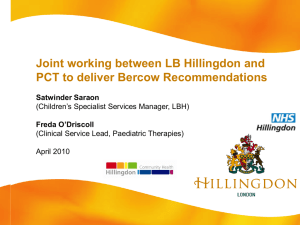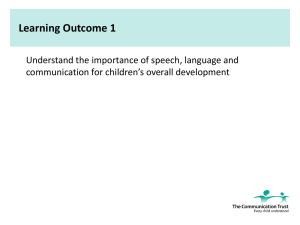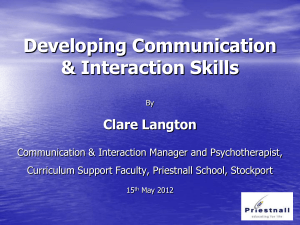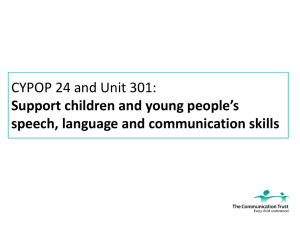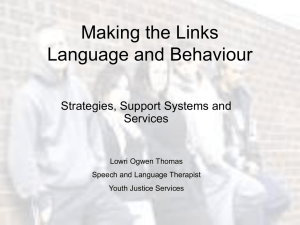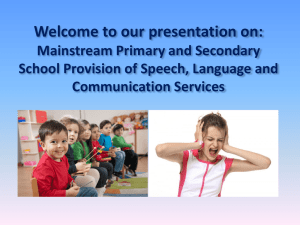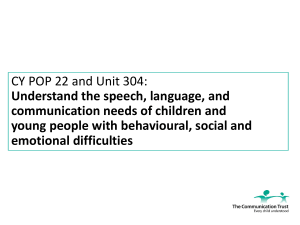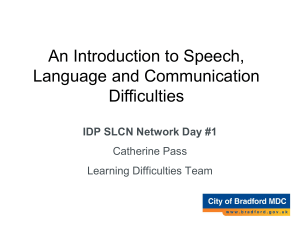Strategies to support children and young people`s SLCN
advertisement
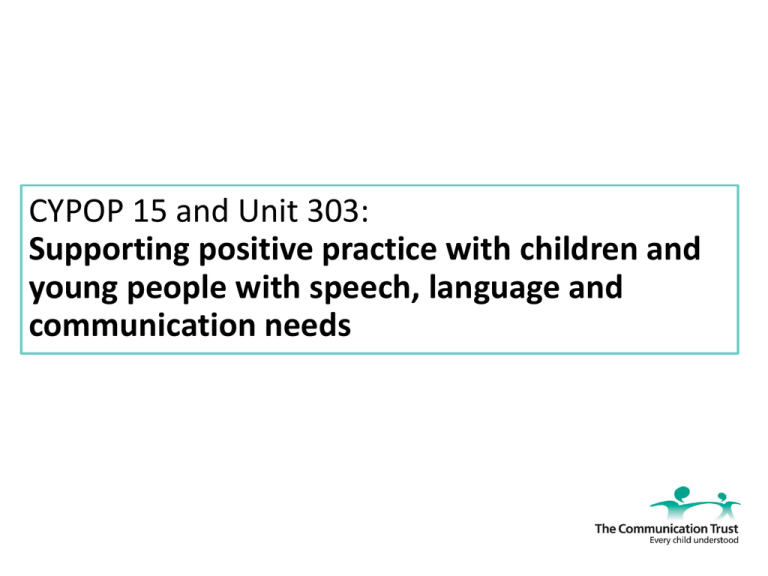
CYPOP 15 and Unit 303: Supporting positive practice with children and young people with speech, language and communication needs Learning Outcome 1 Understand the concept of positive practice when working with children and young people with speech, language and communication needs (SLCN). Revising Speech, Language and Communication This unit is based on a good understanding of: What speech, language and communication are How we support everyone’s speech, language and communication development and skills What Speech, Language and Communication Needs (SLCN) are How common they are and some factors which may contribute to SLCN How we can spot children and young people who may have SLCN Revising speech, language and communication 1 Says ‘sop’ for ‘shop’ Stops what they’re doing if told to ‘hold your horses’ Asks ‘what’s that over there?’ Follows instructions Adds ‘ed’ to finish when they’re done – ‘I’ve finished’ Babbles Names lots of different vehicles Looks at the person talking Waits for their turn to talk Waves good bye Identifies that daddy starts with ‘d’ Describes what they did at the weekend Revising speech, language and communication 1 • In small groups, look at the following examples. • Decide if they describe ‘speech’, ‘language’ or ‘communication. • You may have some differences of opinion and some may overlap. • You may wish to make a note of these discussions too. Revising how you support speech, language and communication • In small groups, share 3 different ways in which you support speech, language and communication in your work. Talk about how you use them and how effective they are. • Try to include an example for each of the following: Supporting speech, language and communication through everyday activities or routines How the environment supports speech, language and communication How you use or adapt your own language to support speech, language and communication Revising SLCN • In pairs, write a definition for Speech, Language and Communication Needs • List 3 different factors which may contribute to a child or young person having SLCN • Look at the following two statements and decide if they are TRUE or FALSE For some children who have SLCN, there is no known reason Children and young people learning more than one language all have SLCN Revising SLCN 2 – what can contribute to a child or young person’s individual pattern of SLCN? What is positive practice? Knowing them well Working well with others Planning Monitoring Evaluating Building on their strengths Building on existing good practice Positive Strategies: Ensure that social and emotional well-being, including confidence and self-esteem are supported alongside speech, language and communication skills Are based on a child or young person’s strengths • Where strategies focus on a specific area of difficulty, these should be used in ways which ensure confidence and selfesteem are supported throughout. • Examples of different strategies will be looked at in learning outcome 2 Activity 1a - Comparing strategies based on strengths or difficulties • In small groups, look at the following strategies • Firstly, choose any strategies that you think use a child or young person’s strengths and why you think this. • Highlight the strategies which you think are based on a child or young person’s difficulties. • Discuss what is different between the two types of strategies • For the strategies targeting a child or young person’s difficulties, how could you make sure these are positive practice • Are there any strategies which you feel are negative and should not be used? Activity 1a Reminding them not to interrupt Teaching new words using all the senses Keeping your sentences short enough for them to understand Correcting their mistakes Telling them they are standing too far away when they’re talking to you Using a visual timetable Adding one word to their sentences Asking questions to help them join in Asking them to repeat what you have said Helping a child to practise saying ‘s’ Using a feely bag for them to describe an object inside Praising them for waiting for their turn Activity 1a – Possible answers Strategies based on strengths Teaching new words using all the senses Keeping your sentences short enough for them to understand Using a visual timetable Adding one word to their sentences Praising them for waiting for their turn Using a feely bag for them to describe an object inside Activity 1b – Positive practice in action? • In pairs, choose one of the case studies in your learner handbook – either Danny or Shellah • How would you find out about their strengths? • Identify any positive strategies which are already being used to support their SLCN • Are any strategies being used which seem to place more focus on their difficulties? • Choose another two positive strategies which you think may be useful Evidence for positive practice • As part of your portfolio, you will need to give examples of evidence for positive practice • Your tutor will give you examples based on the strategies and approach they show you Portfolio task 1.1 • Develop a brief presentation, either for colleagues or parents • This could be a written or verbal presentation • Explain how to recognise and build on a child or young person’s strengths to support their SLCN • Give examples of some positive strategies and how these compare to those based around children’s difficulties • Include examples of evidence describing positive practice Learning Reflection 1 • Identify one thing which you think has been interesting and/or useful from Learning Outcome 1. • How will this change your practice? • In your portfolio, reflect on how your practice has changed and the impact this had on the children or young people you work with. Learning outcome 2 • Know how to work alongside speech, language and communication specialists to use appropriate strategies and targets to support children and young people. A model of support Specialist Targeted Universal Positive strategies include Facilitating communication between peers Adapting adult language and communication Enhancing the environment Positive Strategies Focus on areas of speech, language and communication Using resources and tasks Supporting confidence and self-esteem Discussion point • In small groups, choose one of the areas from the previous slide • Using your experiences, what might be different when these approaches are used at universal and targeted or specialist levels? • For example, think about different SLCN, who is involved, what their roles and responsibilities might be, how target-setting and progress monitoring are used. Process of choosing and using supportive strategies Gather evidence and information What are the roles of: YOU Check what difference it made and what to do next Decide what to do TARGET STRATEGY Plan it and do it SPECIALIST CHILD/ YOUNG PERSON FAMILY Target setting • It is important to set targets for children and young people with SLCN • Targets can help focus specific support for children with SLCN to develop their skills • Effective use of target setting can help show progress • Target setting is based on assessment – this can be informal or formal assessment and may be informed by a number of different professionals • How targets are chosen will vary according to the child or young person and the setting – working together is key Questions to help select targets Assess Where are they now and where do they need to get to? Select What’s the priority? (Child or young person’s may be different to yours) What strengths can we build on? Plan How will we help them get there? What will we do. When? Who will do what? How long will it take? How will we know when we’re there? Use Intervention – using a strategy or approach Review Are we where we wanted to be? What difference has it made? What next? S E T Target setting •Specific •Measurable Targets •Achievable •Relevant •Time-related Activity 2a Considering your role in using targets Target setting Using and Monitoring Evaluating Activity 2b Target setting • In small groups, choose one of the following children: Artem, Josie or Pete. • From the brief descriptions, first decide if their needs seem to relate to speech, language and/or communication. • Discuss how you would go about setting a target for them. • If you can, draft a possible target for them, remembering to make it as SMART as possible. • Share your ideas with the rest of your group Portfolio task 2.1 • In your portfolio, draw a diagram which shows the process of how targets are set, monitored and evaluated for children or young people with SLCN in your setting • For each part of the process, explain your own role and the role of the specialist. Strategies to support children and young people’s SLCN Many different strategies e.g. Adapting adult language and communication Enhancing the environment Using resources and tasks Supporting confidence and self-esteem Facilitating communication between peers A focus on areas of speech, language and communication Will vary according to Child or young person’s: Age Needs Interests Targets Priorities Setting Level of support in place Sources of information There are many accessible, practical guides to supporting children and young people with SLCN. The Inclusion Development Programme also has valuable information, resources and learning activities focusing on children and young people with SLCN in primary and secondary school. Local services will also have specific information, advice and support if you are working with children and young people with SLCN. Strategies to support children and young people’s SLCN - General areas to cover 1. How can good universal strategies effectively support SLCN? 2. Some targeted strategies focusing on particular areas of speech, language and communication 3. Points to consider for specialist strategies and interventions Strategies to support children and young people’s SLCN - Building on universal strategies • Many universal strategies are really useful to support SLCN • However, there are key things to consider when using them at a targeted or specialist level Target setting Why and how strategies are chosen How the strategies are used Strategies Who is involved and how How progress is monitored and shared Activity 2c – Developing universal strategies to support SLCN • Choose a universal strategy which supports all children and young people’s speech, language and communication • It should either be about: Adapting adult language and communication or Activities focusing on speech, language and communication • Outline how you would use this strategy to best effect in your work with a child or young person with SLCN • What is different when you use it to support SLCN? • You could use an example from your practice Activity 2d Using structured interactions to support SLCN • Interaction is an important way for young children to learn, for example children playing imaginatively together, role play, and working together on creative projects. • Older children also benefit from having structured opportunities to discuss their learning. • These approaches support communication development generally– however, you will need to consider ‘extras’ to support children and young people with SLCN to access these opportunities effectively. You will also need to teach or demonstrate skills explicitly • Look at the following examples of structured interactions. How could you make them accessible to all? Examples of structured interaction Structured interaction Feely bag pairs Role play Show and tell Interesting object prompts Paired discussion about a task or activity Ideas to support SLCN Thinking time Give lots of time to respond • Our natural instinct is to leave less than 1 second after asking a question, before jumping in with another question or comment. • Try leaving 3 to 5 seconds after a question, to give children or young people plenty of time to respond. • What do you notice about their response? • This is useful for all children and young people and essential for children with SLCN. Adapting and modifying adult language and communication to support SLCN Label actions and objects with one or two words at a time Use new or target words frequently Model to support their language Minimise words that they won’t understand Chunk information Pause after important points Use gestures or signs to support what you say Give instructions in the order that they need to happen Use reminders Avoid idioms which may be confusing Activity 2e - Adapting adult language • Working in pairs or small groups, look at the following examples of adult talk. • For each one, highlight any potential difficulties you can see which may be problematic for a child or young person with difficulties understanding language. • Then, suggest a way that the adult could change their language to help support understanding better Activity 2e - Adapting our own communication Adult talk Once we’re all sorted and we’ve tidied up the bricks especially, we’re going to go outside and have a run around before we settle back in for painting. What were you thinking this morning, walking around like that? The purpose of the people’s reaction is clear under the circumstances Get your coat after you’ve finished your drink I expect more of you Activity 2f – Observing your own communication • Ask a colleague to observe or record an example of yourself interacting with a child or young person with SLCN. Make sure you have the appropriate permissions • Using your observations: Give an example of when and how you have adapted your language or communication for that child or young person Give any examples of how you could have adapted your language more or differently Discussion - Enhancing the environment to support SLCN A supportive environment for communication Has good light, space and minimal background noise Uses the opportunity to develop vocabulary and literacy by labelling equipment and resources Has clear and consistent routines Has access to relevant and interesting books Has opportunities for activities led by the child or young person Has clear learning areas • Why might these features be particularly important for children and young people with SLCN? Activity 2g - Enhancing the environment to support SLCN • Work in small groups • You have an opportunity to redesign a setting to make its environment as supportive as possible for children or young people with SLCN. • Draw and label what this would look like • Alternatively, take photographs (with permission) of an existing setting. Highlight ways it currently supports SLCN and identify any ways this could be developed further. Adapting resources and tasks • As part of learning outcome 3, you will need to demonstrate how you adapt resources and tasks to support children and young people with SLCN. This includes: Everyday activities Specific resources or activities you use as part of your work (e.g. within a curriculum) Daily routines Published resources and written information Activity 2h - Adapting resources and tasks • Work in small groups. • Choose one of the case studies provided • Think of a task that happens in your setting – it could be an everyday activity, a daily routine or something specific to your role (e.g. something as part of a curriculum) • Bring in a resource you use – this could be a game, book, toy or written materials for example • For both the task and the resource think of how you will adapt them so that they are accessible and beneficial for your case study child. Positive Strategies may focus on particular areas of speech, language and communication: • For example – Listening and attention skills – Developing skills in monitoring their own understanding – Phonological awareness tasks (e.g. syllable awareness, rhyming skills, blending and segmenting) – Word learning and word finding skills – Vocabulary development – Narrative abilities – Sentence building – Social communication skills Activity 2i - Strategies focusing on areas of speech, language or communication • Choose one of the areas of speech, language and communication from the following slide • Describe a strategy you have used to support a child or young person’s SLCN in this area. • Include: Why that strategy was chosen Who it was used with How it was used What the benefits were from using this strategy. • Explain how this was a positive strategy • Share this with your group Strategies focusing on areas of speech, language or communication Speech Attention and listening Learning new words Building spoken language Social communication Telling stories Strategies to support learning new words • • • • • • Teach new words using a range of techniques Label objects and actions often Use real objects to introduce new words Use words often and in context Relate them to what they already know Once words are learnt, relate them to categories , with lots of sorting tasks and discussions around odd-one-out. • Try and involve all of the senses if possible • Represent words visually – use pictures, symbols, fonts to make them memorable Positive Strategies learning new vocabulary 2 • Use techniques such as mind maps, spider diagrams, concept maps to highlight and organise information about: Meaning Sounds Similar words Different contexts • Use questioning to get children and young people to use the words and apply their own meaning, such as: When might you...? How might you....? Have you ever....? Activity 2j - Learning new words • Working with a partner, choose 2 words that you need to introduce to a child or young person with SLCN who you work with • Make a brief plan outlining the different ways you will introduce and support the child or young person to learn these new words. • You could include illustrations to show how you might do this too Research evidence for targeted interventions • Practitioners and researchers are working hard to increase the evidence about ‘what works’ in terms of supporting children and young people with SLCN • Some evidence is from robust research projects • There is also more informal evidence available – where practitioners have tried out interventions and reported positive benefits, although these may not have been so scientifically planned or evaluated as rigorously. Specialist support • Some children and young people have significant SLCN and require specialist support • Those specialists will have detailed knowledge of the child or young person’s strengths and needs, based on thorough assessment • Strategies and approaches would therefore be chosen or developed for individual children and young people and their use would be supported by specialist practitioners Specialist Assessments • Specialist professionals such as speech and language therapists and educational psychologists will often assess children and young people and write reports on what they find out. • These assessments may be based on: –Standardised tests, –Structured observations – Interactions with the child –Informal assessments –Discussions with adults who know the child. Alternative and Augmentative Communication (AAC) • Some children and young people have particular difficulties with speech, have limited speech, or physically can’t speak • Augmentative and Alternative Communication describes the different ways of communicating, either to support speaking (augmentative) or instead of speaking (alternative). • AAC describes a wide range of techniques to support spoken communication. • These include gesture, signing, symbols, word boards, communication boards and books, as well as Voice Output Communication Aids (VOCAs). Discussion – Working alongside specialists • Why is it essential to work together with others to support children and young people with SLCN? Activity 2k - Working alongside speech, language and communication specialists • As a group, think of the specialists who work with children and young people with SLCN • Choose one of them and outline the different ways you work alongside them • Share your different ways of working with your group • Consider if there are any new ways of working with specialists which you feel would be useful for you and the children and young people you work with Working with specialists • If you have concerns about a child/young person’s speech, language and communication skills, your setting may have a process in place to follow up such concerns. • You can use your observations of the child/young person to gather information about their skills, so that you have specific examples to support any concerns. • It is important to keep parents informed of any concerns you may have, discussing their views and discussing potential next steps. Your setting may have guidance on how to keep parents informed and involved. Portfolio task 2.2 • Produce some simple, easy to read leaflets or posters which describe some different strategies and targets to support SLCN. • These could be aimed at colleagues in your setting or parents, carers and families • Include an explanation of how these strategies are chosen and used. • You will also need to compare different examples of how strategies and targets have been used Learning Reflection 2 • Identify one thing which you think has been interesting and/or useful from Learning Outcome 2. • How will this change your practice? • In your portfolio, reflect on how your practice has changed and the impact this had on the children/young people you work with. Learning Outcome 3 • Be able to place children and young people at the centre of professional practice when working with children and young with speech, language and communication needs. Discussion • Why is it important to put the child or young person in the centre of our practice? • As a group, highlight the reasons why this is essential. Child-centred practice • Each child and young person has a unique profile of strengths and difficulties. • The circumstances around the child’s strengths and difficulties also vary. • Factors such as the environment, support and resources, other life events and experiences will all impact on how best to support a child. • There can be no ‘one size fits all’ package of support. Activity 3a Issues and implications in settings • In small groups, think of a setting you know well. • Choose one of the areas below • Identify any possible issues there could be for children with SLCN. Adult language Activities and tasks Social opportunities The environment Opportunities for children and young people’s views Children and young people’s views - discussion • Children and young people have insightful and unique views on their own strengths, difficulties, how they can best be supported and how they learn most effectively. • There are different approaches to finding out the views of children and young people. • How does your setting currently find out the views of the children and young people that you work with? • How does this work for any children and young people with SLCN? • How effectively does your setting use these views to inform practice? Approaches to gain children and young people’s views • Ask them! • Use a standardised questionnaire • Work together to develop a strategies advice sheet (or communication passport) • Talk with them about strategies you may use – when you’ve tried it, ask them what they think – how did it help; how did they feel about it – was it fun, interesting; what difference did it make? What else and what next? • Using simple rating scales to get feedback Activity 3b - Strategies Advice Sheet Work with a child or young person in your setting to create a strategies advice sheet for adults to use with them. 1. Spend time chatting to the child or young person about why you’re making the advice sheet. 2. Decide on what to put in it the advice sheet, with suggested sections on ‘About Me’, ‘Things I find difficult’, ‘Ways I can help myself’ and ‘Things you can do to help’. 3. Decide on who to share the advice sheet with. Activity 3b Example Advice Sheet About Me: • • • • • • I am 7 years old. I like dogs. I have a dog called Pansy. I like playing on my x-box and playing outside with my brother Joe. My favourite lesson is Music. My favourite film is Kung Fu Panda 2. I am good at making flapjacks and drawing Stork from Kung Foo Panda. Things I find difficult: • I find it hard to understand teachers when they talk for ages and ages. • I can’t learn new words very quick. • I get shy talking in class. • • • • • • • • • I can help myself by: Asking Miss White when I get stuck. Looking at the teacher when she talks Using my fingers to remember what I have to do. Put my hand up if I can guess an answer. You can help me by: Don’t ask me unless I put my hand up. Talk to me about the things I like. I like drawing mind maps of new school words. Tell me what to do one bit at a time. Check I understood what you mean. A simple rating scale Use a simple rating scale with a child or young person you are working with Portfolio task 3.1 • Identify any issues and implications in your work setting for children and young people with SLCN. For example: Is the environment ‘communication friendly’? Are activities and tasks accessible for children and young people with SLCN? Are social opportunities also accessible? Are staff able to support children and young people with SLCN confidently? Are there effective opportunities to listen to the views of children and young people with SLCN in your setting? • Develop a simple action plan to outline how these can be minimised or overcome Portfolio task 3.2 • This task will be assessed in relation to your work setting and is an opportunity for you to show how you have put your learning about supporting children and young people with SLCN into practice. • Keep a reflective diary of some different ways you have supported children or young people with SLCN. In your diary, you will need to include examples of how you have adapted and modified: Your own communication Resources and tasks Learning Reflection 3 • Identify one thing which you think has been interesting and/or useful from Learning Outcome 3. • How will this change your practice? • In your portfolio, reflect on how your practice has changed and the impact this had on the children/young people you work with. Learning Outcome 4 • Understand how to work with others to support the social, emotional and cognitive needs of children and young people. Learning Outcome 4 • Speech, language and communication skills are associated with all aspects of development, at all stages of development: Cognitive development and learning Social skills Emotional development Behaviour • Because of these very close links, SLCN can impact on any or all of these areas of development SLCN and social development Understanding social language eg jokes, sarcasm Making new friends Being able to join in conversations Dealing with misunderstandings Confidence in social situations Social development Linking causes and consequences SLCN and emotional development • Understanding and using emotion vocabulary • Understanding causes and Possible consequences impacts of • Building relationships SLCN on emotional • Perception of own development communication skills • Confidence and self-esteem SLCN and learning • SLCN has the potential to affect many aspects of learning eg: – Accessing new information and concepts – Finding information difficult to follow can lead to children and young people switching off – SLCN is sometimes associated with reduced short term and working memory – Reduced word knowledge can be a further barrier to learning – Language is required for ‘thinking things through’ during problem solving – The ability to demonstrate and develop learning through giving explanations Activity 4a - The possible impacts of SLCN • Think of a child or young person you work with • Briefly summarise their SLCN • Consider how their SLCN may impact on each of the following areas of development Social Emotional Cognitive • You may wish to consider short and long term impacts. • You could use one of the brief case studies provided if you prefer. How can social, emotional and cognitive needs affect speech, language and communication? Possible effects on speech, language and communication Social, emotional or cognitive need Potential impact on further social, emotional or cognitive development Activity 4b - Social, emotional and cognitive needs and speech, language and communication? • In small groups, choose one of the following case studies • For each, think about the possible impacts on their speech, language and communication • Then think of any possible subsequent effects on their social, emotional or cognitive development • You can record your ideas on the diagram in your handbook Activity 4c - The roles of other professionals • Other specialists will have roles in giving additional support for social, emotional and cognitive needs. Who might these be? • Choose one and find out about their role in working with children and young people with SLCN and how to access their support • Share your findings with your group. Portfolio task 4.1 • Prepare for a short professional discussion on speech, language and communication and social, emotional and cognitive needs. • This discussion could be either with work colleagues or other learners. Your tutor will let you know if you will be assessed through your notes or through an actual discussion. • To support your discussion, make some brief notes to explain: How SLCN can affect children and young people’s social, emotional and cognitive development How social, emotional and cognitive needs can affect speech, language and communication Portfolio task 4.2 • Draw a diagram or complete a table to show other professionals who may be involved in supporting children and young people with SLCN. • Include some information on each of their roles. • Identify how they may support the social, emotional and cognitive needs of children and young people with SLCN. • Highlight any professionals who are particularly relevant for the children and young people you work with and explain how you would access additional support from them Learning Reflection 4 • Identify one thing which you think has been interesting and/or useful from Learning Outcome 4. • How will this change your practice? • In your portfolio, reflect on how your practice has changed and the impact this had on the children/young people you work with. Hello 2011 is the National Year of Communication ‘Hello’ is a national campaign run by The Communication Trust, complementing the Government’s commitment to support children with speech, language and communication needs. Please visit www.hello.org.uk for more information on how you and your setting can help improve the communication skills of children and young people – so that they can live their life to the full.
